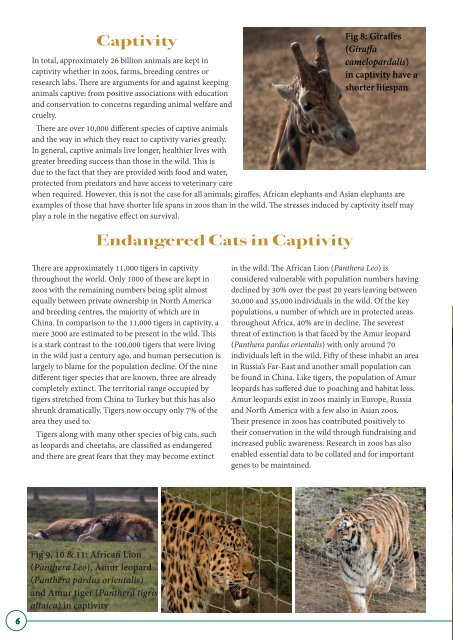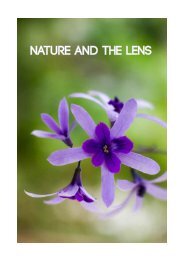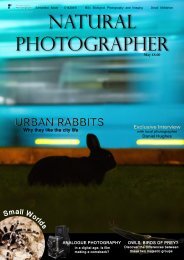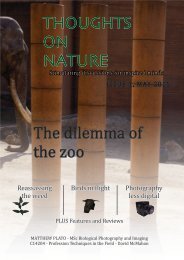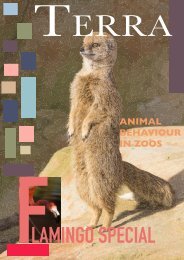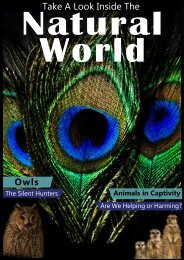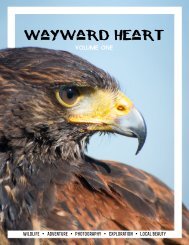Saving Wild Cats
You also want an ePaper? Increase the reach of your titles
YUMPU automatically turns print PDFs into web optimized ePapers that Google loves.
Captivity<br />
In total, approximately 26 billion animals are kept in<br />
captivity whether in zoos, farms, breeding centres or<br />
research labs. There are arguments for and against keeping<br />
animals captive: from positive associations with education<br />
and conservation to concerns regarding animal welfare and<br />
cruelty.<br />
There are over 10,000 different species of captive animals<br />
and the way in which they react to captivity varies greatly.<br />
In general, captive animals live longer, healthier lives with<br />
greater breeding success than those in the wild. This is<br />
due to the fact that they are provided with food and water,<br />
protected from predators and have access to veterinary care<br />
when required. However, this is not the case for all animals; giraffes, African elephants and Asian elephants are<br />
examples of those that have shorter life spans in zoos than in the wild. The stresses induced by captivity itself may<br />
play a role in the negative effect on survival.<br />
Endangered <strong>Cats</strong> in Captivity<br />
There are approximately 11,000 tigers in captivity<br />
throughout the world. Only 1000 of these are kept in<br />
zoos with the remaining numbers being split almost<br />
equally between private ownership in North America<br />
and breeding centres, the majority of which are in<br />
China. In comparison to the 11,000 tigers in captivity, a<br />
mere 3000 are estimated to be present in the wild. This<br />
is a stark contrast to the 100,000 tigers that were living<br />
in the wild just a century ago, and human persecution is<br />
largely to blame for the population decline. Of the nine<br />
different tiger species that are known, three are already<br />
completely extinct. The territorial range occupied by<br />
tigers stretched from China to Turkey but this has also<br />
shrunk dramatically. Tigers now occupy only 7% of the<br />
area they used to.<br />
Tigers along with many other species of big cats, such<br />
as leopards and cheetahs, are classified as endangered<br />
and there are great fears that they may become extinct<br />
Fig 8: Giraffes<br />
(Giraffa<br />
camelopardalis)<br />
in captivity have a<br />
shorter lifespan<br />
in the wild. The African Lion (Panthera Leo) is<br />
considered vulnerable with population numbers having<br />
declined by 30% over the past 20 years leaving between<br />
30,000 and 35,000 individuals in the wild. Of the key<br />
populations, a number of which are in protected areas<br />
throughout Africa, 40% are in decline. The severest<br />
threat of extinction is that faced by the Amur leopard<br />
(Panthera pardus orientalis) with only around 70<br />
individuals left in the wild. Fifty of these inhabit an area<br />
in Russia’s Far-East and another small population can<br />
be found in China. Like tigers, the population of Amur<br />
leopards has suffered due to poaching and habitat loss.<br />
Amur leopards exist in zoos mainly in Europe, Russia<br />
and North America with a few also in Asian zoos.<br />
Their presence in zoos has contributed positively to<br />
their conservation in the wild through fundraising and<br />
increased public awareness. Research in zoos has also<br />
enabled essential data to be collated and for important<br />
genes to be maintained.<br />
Breeding & Genetics in Captivity<br />
Breeding programmes are one way in which zoos and<br />
breeding centres hope to increase population numbers<br />
with the possibility of eventually releasing individuals<br />
back into the wild.<br />
There are concerns over these breeding programmes<br />
as, with most endangered species, populations within<br />
captivity are relatively small. Even among small<br />
populations in the wild, breeding within these groups<br />
leads to a loss of genetic diversity as the gene pool<br />
is reduced. This can result in genetic mutations and<br />
reduces the chances of that population’s sustained<br />
survival. This is one problem incurred by the small<br />
numbers that make up the current wild Amur leopard<br />
population. In addition to this, captive animals also<br />
develop genetic adaptations in response to captivity<br />
through both natural and artificial selection.<br />
In order to minimise the chances of these genetic<br />
adaptations impacting a species’ chance for survival,<br />
measures are taken to control population growth and<br />
limit the number of generations reared in captivity. One<br />
way to do this is to delay reproduction by separating<br />
Fig 12: A captive<br />
Amur tiger<br />
(Panthera tigris<br />
altaica) grooming<br />
male and female members or by using reversible<br />
contraceptive methods. Separating males and females<br />
can lead to aggression and stress and so contraceptive<br />
methods may be better in terms of allowing social<br />
interactions to remain as natural as possible. The<br />
reversibility of these forms of contraception is vital<br />
especially when administered to individuals with strong<br />
genes and desirable traits.<br />
Contraceptive methods do have side effects however<br />
and these are shown to vary between species. The use<br />
of hormonal implants has been shown to result in a<br />
lower chance of successful reproduction in the Amur<br />
tiger (Panthera tigris altaica) whilst the African lion<br />
displays a loss of secondary sexual characteristics. Oral<br />
contraception leads to aggression in the Amur leopard<br />
and the African lion with the former also refusing food<br />
and the latter exhibiting weight loss and masculisation.<br />
In all three species, some forms of contraception also<br />
increase the likelihood of individuals contracting<br />
disease as a result of reproduction.<br />
Fig 9, 10 & 11: African Lion<br />
(Panthera Leo), Amur leopard<br />
(Panthera pardus orientalis)<br />
and Amur tiger (Panthera tigris<br />
altaica) in captivity<br />
7


